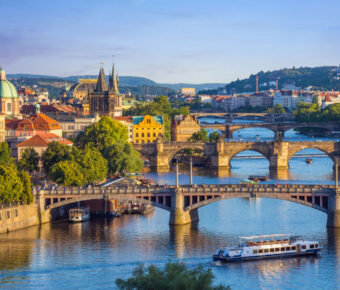
What NOT to Do in Santorini: 12 Costly Mistakes & Insider Tips
Santorini looks like a dream in photos, but wow, it’s so easy to stumble into mistakes that can sour the trip. Crowds, overpriced meals, and wasted time on the wrong activities sneak up fast if you’re not prepared. Honestly, knowing what not to do in Santorini saves you money, stress, and a whole lot of disappointment.
You might expect every beach to be picture-perfect, but trust me, some are rocky, windy, or just not worth the trek. The island’s layout can be a bit of a maze—if you spend too much time in one spot, you’ll miss those hidden villages and quiet corners that feel a world away from the tourist crush.
Transportation? It can turn into a headache if you don’t think ahead. Buses run late, taxis cost more than you’d guess, and driving those narrow cliff roads isn’t exactly for the faint of heart.
Table of Contents
- Key Takeaways
- Avoiding Overtouristed Spots at the Wrong Time
- Crowds at Oia During Sunset
- Overwhelmed Streets in Fira
- Peak Season Pitfalls
- Mistakes with Santorini’s Unique Geography
- Ignoring the Caldera’s Safety Warnings
- Underestimating the Volcanic Terrain
- Skipping Akrotiri’s Archaeological Sites
- Transportation Traps to Dodge
- Relying Only on Taxis
- Driving Without Local Knowledge
- Missing Out on Scenic Walks
- Overlooking Nearby Cycladic Islands
- Ignoring Day Trips to Ios
- Missing Ferry Connections to Mykonos
- Forgetting About Milos and Tinos
- Common Accommodation Errors
- Booking the Wrong Location
- Underestimating Hotel Demand
- Not Checking for Authentic Cave Hotels
- Missteps at Santorini’s Beaches
- Expecting Sandy White Beaches
- Neglecting Beach Safety
- Missing Out on Kamari and Perivolos
- Cultural and Culinary Faux Pas
- Overlooking Local Wineries
- Missing Traditional Greek Cuisine
- Ignoring Local Customs
- Failing to Explore Santorini’s Lesser-Known Gems
- Skipping Amoudi Bay
- Missing Skaros Rock and Imerovigli
- Neglecting the Prehistoric Museum
- Travel Planning Blunders
- Not Booking in Advance
- Ignoring Weather Patterns
- Overpacking for the Island
- Frequently Asked Questions
- Which areas in Santorini should tourists be cautious about visiting for safety reasons?
- Are there any particular local customs in Santorini that visitors should be careful not to offend?
- What are some common mistakes tourists make when dressing for a vacation in Santorini?
- Can you identify certain tourist activities in Santorini that are considered overrated or not worthwhile?
- What behaviors should be avoided on Santorini beaches to respect Greek beach etiquette?
- What actions are deemed disrespectful when interacting with the residents of Santorini?
- Book Your Dream Experience
- More Travel Guides
Key Takeaways
- Avoid crowded spots during peak hours
- Plan transport wisely to save time and stress
- Explore beyond the popular tourist areas
Avoiding Overtouristed Spots at the Wrong Time
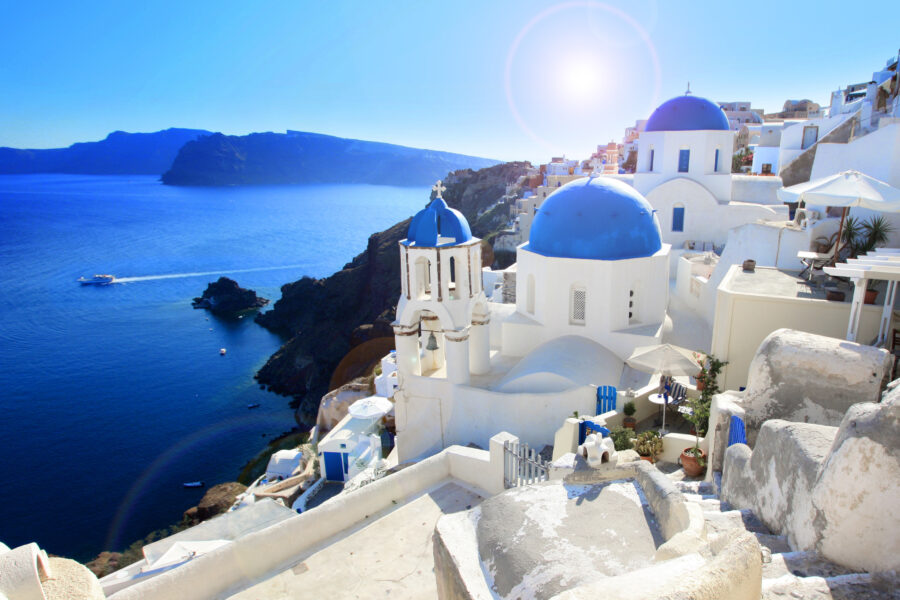
Some of Santorini’s most beautiful places can also be the most frustrating if you show up at the wrong hour. The island’s magic is there, but it’s easy to lose it in shoulder-to-shoulder crowds, slow traffic, and long waits for even a simple meal.
Crowds at Oia During Sunset
Oia’s sunset — or pôr do sol em Oia if you’ve heard it called that — draws people from everywhere. The sky turns soft pinks and oranges, and the whitewashed houses just glow. But here’s the catch: hundreds, sometimes thousands, of people pack those narrow lanes long before the sun even starts to drop.
Arrive less than an hour before sunset, and you’ll probably find every prime spot already claimed. People camp out on walls, steps, and even awkward corners. Moving through the crowd feels a bit like shuffling out of a packed concert.
You can still enjoy Oia without the chaos, though. Go early in the morning for quiet streets, or watch the sunset from less crowded spots like Pyrgos or Akrotiri. If you’re set on a sunset view in Oia, try booking a small-group tour with a reserved terrace.
Overwhelmed Streets in Fira
Fira is the island’s busiest hub — and honestly, that’s not always a good thing. When cruise ships dock, thousands of passengers pour into town at once. The streets, already narrow and winding, jam up with tour groups, selfie-takers, and shoppers.
Shops and cafés get so full you can’t even step inside without waiting. Walking from one side of town to the other slows to a crawl when the lanes are packed.
If you need to be in Fira during peak hours, plan your route ahead and skip the main shopping drag. Early mornings or after 8 p.m. feel much calmer. The caldera views are so much easier to enjoy when you’re not dodging a sea of people.
Peak Season Pitfalls
July and August bring the biggest crowds and wallet-busting prices. Hotels fill up months ahead, and even casual tavernas can require reservations. The heat makes walking packed streets feel even more exhausting.
It isn’t just Oia and Fira—beaches like Kamari and Perissa get crowded, with sunbeds booked out by mid-morning. Buses run more often, but they’re usually standing-room only.
If you can swing it, visit in late spring or early autumn. You’ll still get warm weather and long days, but you’ll dodge the worst of the congestion. Even in peak season, you can escape the crowds by heading to smaller inland villages or exploring early in the day.
Mistakes with Santorini’s Unique Geography
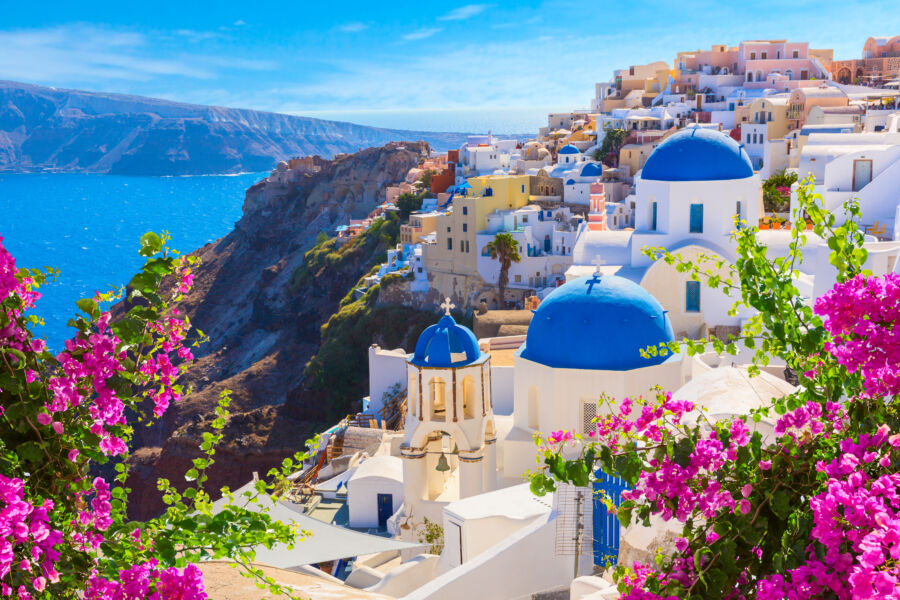
Santorini’s landscape isn’t just a pretty backdrop for your Instagram. The island’s caldeira do vulcão, volcanic islands, and ancient ruins all come with quirks, challenges, and even a few risks if you’re not paying attention.
Ignoring the Caldera’s Safety Warnings
The caldera’s cliffs look stunning, but honestly, they’re unstable in places. You’ll spot warning signs about loose rock, restricted paths, or high winds — and they’re not just there for decoration. I’ve watched people lean over the railings for a selfie, only to lose their hat (or worse) to the wind.
If you take a boat trip to Nea Kameni or Palea Kameni, listen up when the crew gives instructions. The volcanic slopes get slippery, especially after rain. And the heat from the ground in certain spots is no joke — wear real shoes, not flimsy sandals.
Stay a few steps back from cliff edges in Fira or Oia. The views are just as good, and you won’t risk a nasty fall. Treat the caldera like the active volcanic structure it is, not just a pretty overlook.
Underestimating the Volcanic Terrain
Santorini’s volcanic ground isn’t your average hiking trail. The dark rock soaks up heat fast, so mid-day walks can feel like you’re standing on a stovetop. I learned this the hard way and had to cut a hike short because my shoes were almost too hot to touch.
The paths on Nea Kameni are uneven, with loose gravel shifting under your feet. Trekking poles come in handy if you’re not steady on rocky ground. And don’t forget water—there’s zero shade, and the sun bouncing off the pale pumice makes it feel even hotter.
If you’re planning to swim near Palea Kameni’s hot springs, know that the iron-rich water stains light-colored swimsuits. It’s a small thing, but I’ve seen travelers regret not wearing an old suit for that dip.
Skipping Akrotiri’s Archaeological Sites
Akrotiri isn’t just another pile of old stones — it’s a Bronze Age city preserved under volcanic ash, often called the “Pompeii of the Aegean.” If you skip it, you’re missing one of the most important archaeological sites in Greece.
The covered excavation site makes it accessible even on hot days. You can walk along raised platforms and see multi-story buildings, pottery, and frescoes that survived the eruption around 1600 BC.
If you’re short on time, pair Akrotiri with a stop at the nearby Red Beach. It’s one of the few spots where you can see the island’s volcanic layers up close — a reminder of the wild forces that shaped Santorini’s geography.
See Related: Santorini Bus Schedule: Complete Guide to Island Transportation for Summer 2025
Transportation Traps to Dodge
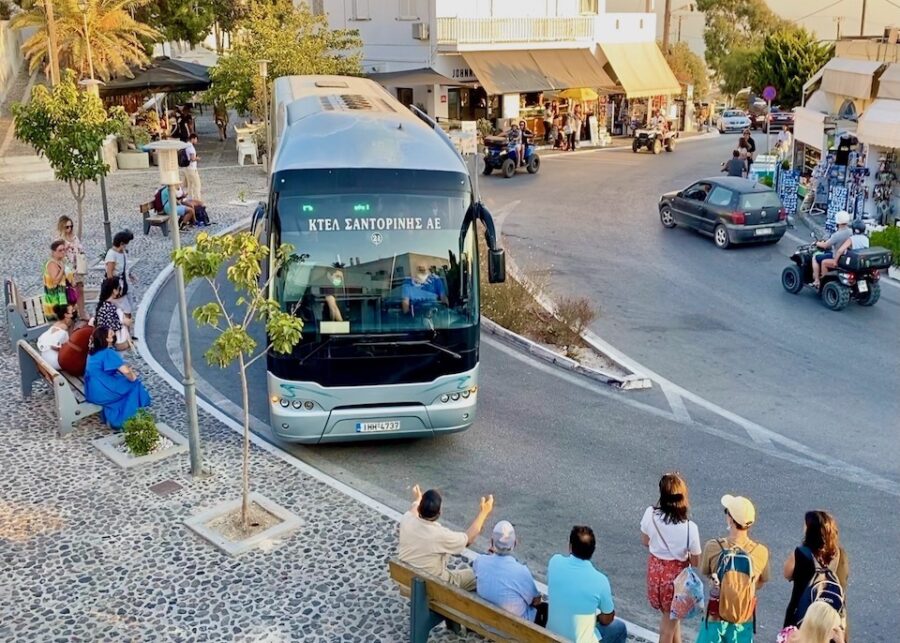
Getting around Santorini can be surprisingly tricky if you don’t plan ahead. The island’s mix of narrow roads, steep hills, and busy tourist areas means some choices can waste your time, money, or patience. I’ve learned the common pitfalls the hard way, so here’s how you can enjoy more of Fira, Oia, Firostefani, and Imerovigli.
Relying Only on Taxis
Santorini taxis are limited, and during peak hours, you might end up waiting 30 minutes or more—especially at the ferry port or airport. Fares add up quickly, especially for trips between Oia and Fira.
Drivers sometimes charge extra if you’re carrying luggage. And unlike big cities, taxis don’t line every corner. In smaller villages, you might not spot one at all.
Public buses are a cheaper option, though they can be crowded. Renting a car or ATV for a day or two gives you more freedom to explore remote spots. Just make sure you compare rates and availability before you book flights so your transport plan lines up with your arrival times.
Driving Without Local Knowledge
Driving in Santorini isn’t like cruising down a wide highway. Roads are narrow, winding, and often shared with buses, pedestrians, and the occasional donkey. Parking in Oia and Fira is scarce, and some lots require a steep uphill walk to reach the main streets.
If you’re not used to a manual transmission, think twice before renting a car here. Most rental vehicles are stick shift, and stalling on a hill with traffic behind you is nobody’s idea of fun.
I’ve watched visitors get stuck trying to turn around in tiny lanes in Imerovigli, blocking traffic for ten minutes. Study the island map, know where the public lots are, and avoid peak driving times in the late afternoon when tour buses return.
Missing Out on Scenic Walks
One of the best ways to see Santorini is simply on foot, yet so many people skip it. The Fira to Oia hike—about 9 kilometers—winds along the caldera and gives you views you just won’t get from a car or bus.
The path passes through Firostefani and Imerovigli, letting you stop for coffee, photos, or a quick snack. You can walk in either direction, but starting in Fira gives you a gentle downhill finish.
Wear sturdy shoes, bring water, and start early to dodge the midday heat. Even if you don’t do the whole hike, walking smaller sections gives you a much better feel for the island than zipping past in a vehicle.
Overlooking Nearby Cycladic Islands

It’s so easy to get swept up in Santorini’s caldera views and sunsets, but the nearby Cycladic islands in the Mar Egeu offer experiences you just won’t find on the main tourist trail. A short ferry ride can take you to quieter beaches, authentic villages, and landscapes that feel a world away from the cruise ship crowds.
Ignoring Day Trips to Ios
Ios sits less than an hour from Santorini by ferry, yet most travelers skip it entirely. That’s a real miss if you love laid-back beaches and small-town charm.
While Ios has a bit of a party reputation, it’s also home to peaceful bays like Mylopotas and hidden coves you can reach by boat. The whitewashed Chora is perfect for a slow wander in the morning before the sun gets too hot.
Go early and return in the evening—you can fit in a swim, a proper Greek lunch, and a stroll through the hilltop lanes. Ferries run often in summer, so you don’t have to stay overnight unless you want to.
Missing Ferry Connections to Mykonos
Mykonos is a different vibe—glamorous, busy, and buzzing with energy. Even if it’s not your style for a whole holiday, a quick trip can be worth it for its beaches and architecture.
The ferry from Santorini takes about two hours, so it’s a realistic day or overnight trip. If you’re flying internationally, Mykonos sometimes has better or cheaper connections, so timing your visit could save money on flight deals.
Wandering Mykonos Town’s narrow alleys in the early morning is a treat before the crowds show up. You can also hop to nearby Delos for ancient ruins that rival anything on Santorini.
Forgetting About Milos and Tinos
Milos is a bit farther, but its coastline is one of the most varied in the Cíclades. Beaches like Sarakiniko, with its white volcanic rock, look almost lunar. The island stays quieter than Santorini, especially outside August, and boat tours show you caves and coves you just can’t reach by car.
Tinos, on the other hand, is famous for its traditional villages and marble craft. It’s less touristy, with a strong local culture and a slower pace. Pilgrims visit its famous church, but you’ll also find excellent food and hiking trails winding through terraced hillsides.
Both islands give you a deeper look at Cycladic life without the heavy tourist footprint, making them worth the extra ferry ride.
Common Accommodation Errors
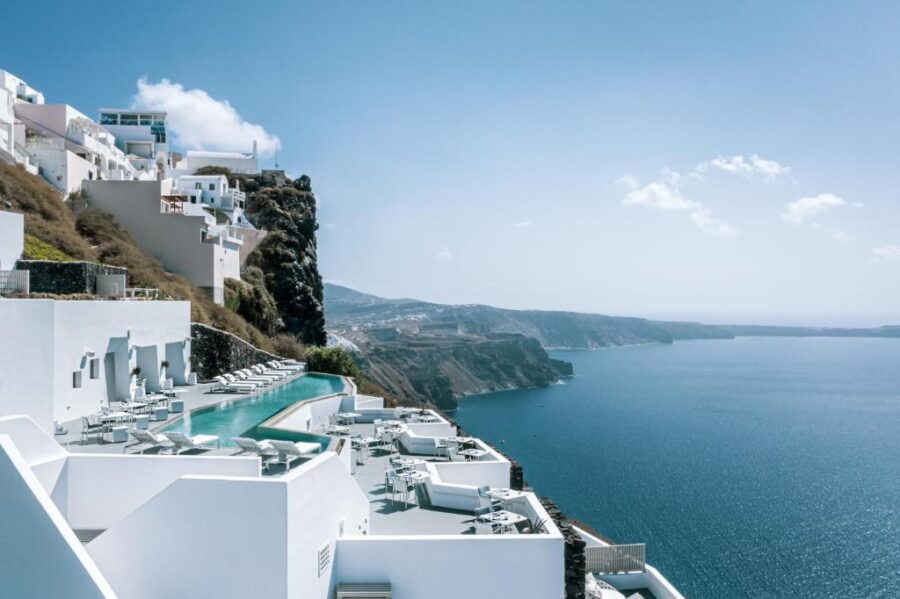
Finding the right place to stay on the Ilha de Santorini can make or break your trip. Location, timing, and the type of hotel you pick all play a huge role in how much you enjoy your stay. Small mistakes here can lead to higher costs, long walks, or missing out on the island’s charm.
Booking the Wrong Location
Let’s be honest, it’s easy to pounce on the first hotel deal that pops up online. But here’s the thing: Santorini’s towns each have their vibe. Oia? Unreal sunsets, sure, but brace yourself for crowds and sky-high prices. Fira? It’s where the nightlife buzzes and buses crisscross the island, though it can get a bit loud for some tastes.
If you’re picturing lazy days on a quiet beach, Kamari or Perissa might suit you better. But if you stay too far from what you want to do, you’ll spend more time on buses than on the sand.
Before you click “book,” really think about how you’ll get around. The buses connect the main towns, but they move at a snail’s pace during peak season. I love renting a scooter or ATV, but parking in Oia? It’s a nightmare. If you want to stroll to dinner or sunset spots, pick a spot that matches your energy and style.
Underestimating Hotel Demand
Santorini isn’t big, and the best hotels go fast. Wait until the last minute in summer and you’ll either pay a fortune or end up somewhere far from those dreamy caldera views.
I’ve watched travelers arrive without a booking, only to settle for places miles from where they wanted to be. If you’ve got your heart set on Oia or Fira—especially if you want a balcony with a view—book months in advance.
Even outside peak season, weddings and events can wipe out availability in a flash. Use solid booking platforms to compare and grab your hotéis em Santorini early. It’s less stressful, and you’ll usually snag a better deal. I like find hotels for filtering by location, amenities, and budget.
Not Checking for Authentic Cave Hotels
Cave hotels are one of those “only in Santorini” things, but not every so-called “cave room” is carved into the rock. Some places just slap on a curved wall and hike up the price.
The real deal? Those rooms stay cool even in summer, with thick stone walls and arched ceilings. There’s a certain Cycladic magic to them.
Don’t just trust the promo shots—dig into guest photos and reviews. Double-check if the place is really built into the cliff or just faking it. In Oia and parts of Fira, true cave suites usually face the caldera, but not every one comes with a private terrace. If that matters to you, ask before you book.
If you’re after the full experience, expect to pay more and book early. The best cave hotels are tiny, so they disappear fast.
See Related: Santorini vs Ios: Which Greek Paradise Matches Your Travel Style in 2025
Missteps at Santorini’s Beaches
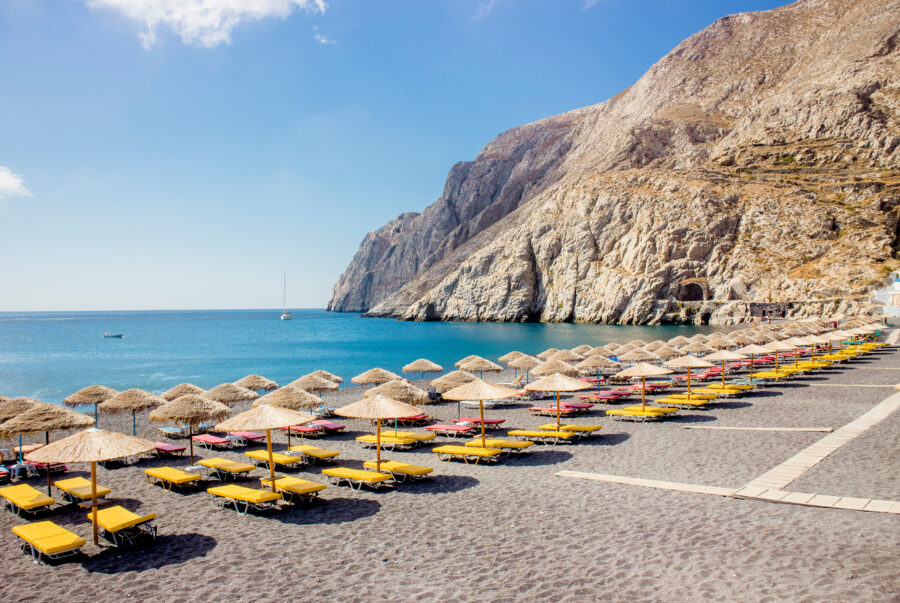
A lot of folks arrive expecting one thing and get something totally different. Some people leave disappointed because they stuck to the most famous names, or just didn’t plan for Santorini’s quirky beaches.
Expecting Sandy White Beaches
If your mind’s eye sees endless white sand like the Caribbean, you’re in for a bit of a shock. Most praias de Santorini are black, red, or even grey volcanic sand and pebbles. It’s gorgeous, but it’s not the fluffy, powdery stuff.
The dark sand heats up fast. By noon, it’s almost too hot to walk on, so bring water shoes or sandals you don’t mind getting sandy. I’ve watched people do the “hot sand dance” straight into the sea because they came unprepared.
Red Beach looks amazing, but it’s more about the views than comfort. Pebbles can be rough on bare feet, and the water sometimes drops off quickly. If you want gentle, tropical shallows, you might be underwhelmed.
Neglecting Beach Safety
Santorini’s beaches aren’t exactly dangerous, but you’ve got to pay attention. The volcanic seabed can drop off fast, and currents—especially on the east coast—are sneakier than they look.
I once saw a couple drift out farther than they planned at Perissa. They swam back fine, but it was a wake-up call: stay where you can stand unless you’re a strong swimmer.
Shade is rare. Unless you rent a lounger or bring an umbrella, you’ll bake. Trust me, sunscreen alone won’t save you if you’re out all day. And those black sands? They’ll fry your feet fast.
Missing Out on Kamari and Perivolos
Some travelers skip Kamari Beach and Perivolos because they’re chasing the “famous” Red Beach or just want caldera views. Big mistake. These two are among the easiest and most comfortable praias de Santorini.
Kamari’s got a long promenade lined with cafés, shops, and tavernas. It’s perfect if you want to mix beach time with a lazy lunch or evening stroll. The vibe feels lively but never nuts.
Perivolos, down south, spreads out with wide sands and a more chilled-out scene. You’ll find loads of sunbeds, water sports, and beach bars—minus the crowds. If you want a full-service beach day without the hassle, this is where I’d go.
Cultural and Culinary Faux Pas
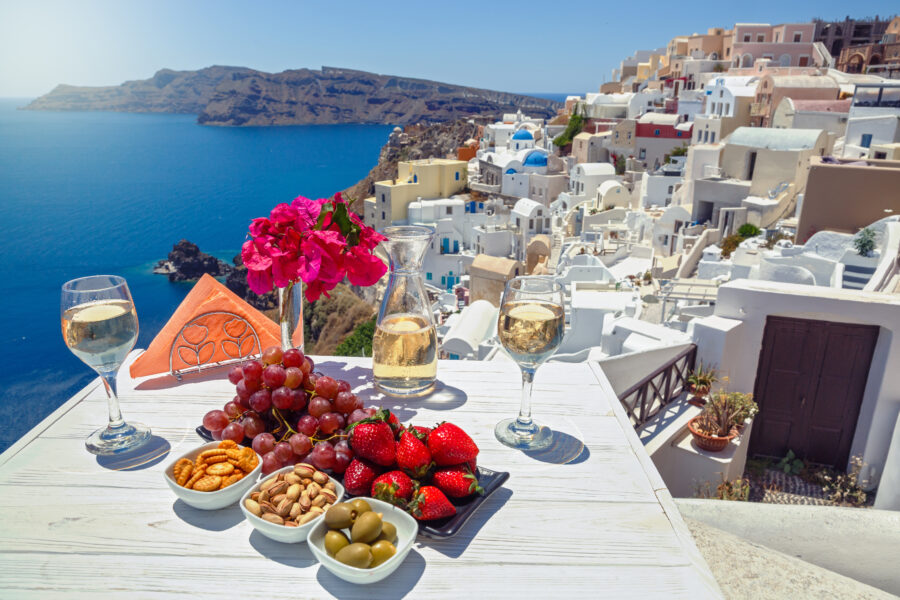
Santorini is more than blue domes and sunsets — it’s a living island with traditions and flavors you shouldn’t skip. If you breeze past the local culture or stick to what’s familiar, you’ll miss out on what makes Grécia so special.
Overlooking Local Wineries
Coming to Santorini and skipping the wineries? You’re missing a huge slice of the island’s soul. The volcanic soil gives the wines a flavor you won’t find anywhere else.
Santo Wines hosts tastings with jaw-dropping views. Sometimes it’s hard to pay attention to the glass in your hand, but you should — especially for the crisp Assyrtiko.
You don’t have to be a wine nerd. Even if you rarely drink, seeing those basket-shaped vines hugging the ground to dodge the wind is fascinating.
Book a tasting for late afternoon. You’ll catch that golden light over the caldera and dodge the rush of midday bus tours.
Missing Traditional Greek Cuisine
It’s easy to stick with the same “safe” foods you know from home, but Santorini’s food scene is worth a little adventure. There’s so much more than Greek salad and gyros here.
Order fava (local yellow split peas) or tomatokeftedes — fried tomato fritters that taste like pure summer. Fresh fish, simply grilled with olive oil and lemon, is a must.
Don’t sleep on the family-run tavernas. They might not have fancy menus, but the food tastes like it came straight from someone’s kitchen.
If you’re lost on what to try, just ask the server what’s good that day. I’ve discovered some of my favorite dishes that way.
Ignoring Local Customs
Santorini welcomes tourists, but you can’t just do whatever you want. A little respect goes a long way.
In churches, cover your shoulders and knees, and keep your voice down. Locals won’t throw you out, but they’ll notice if you treat the place like a selfie backdrop.
Tip about 10% in restaurants. Bargaining in shops isn’t a thing here—save your haggling for taxi fares, though even that rarely works.
Public drunkenness doesn’t fly. Enjoy your drinks, but keep it classy when walking home at night. It’s better for everyone, including you.
Failing to Explore Santorini’s Lesser-Known Gems
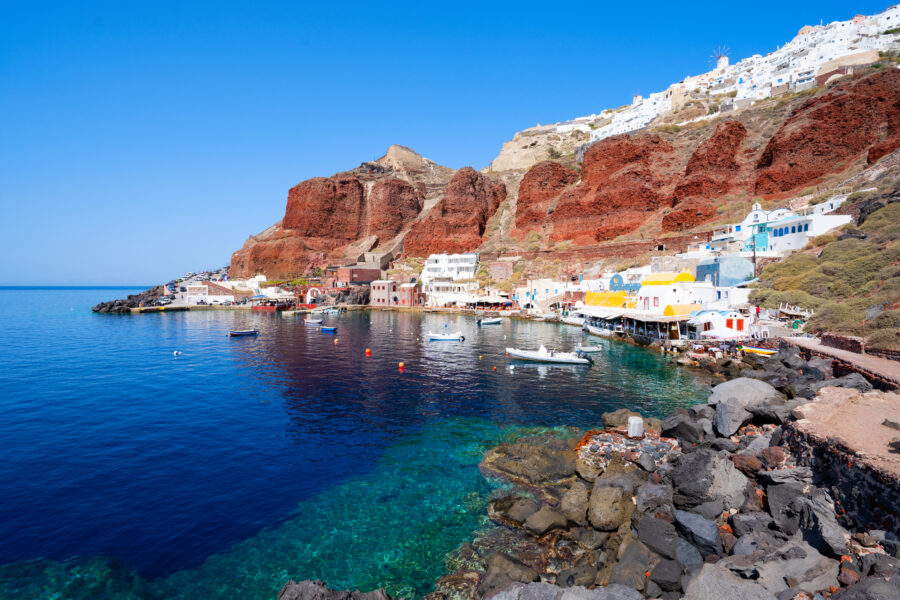
So many travelers stick to the same crowded spots and miss places that show a whole different side of the island. The quieter corners offer unique views, history, and a vibe you just can’t get in the busy areas.
Skipping Amoudi Bay
Amoudi Bay sits just below Oia, but you’d be surprised how many people never make the trek down. This little fishing harbor serves up clear turquoise water, family-run tavernas, and some of the freshest seafood on the island.
If you love swimming, there’s a rocky spot just past the restaurants with deep, calm water. It’s not a sandy beach, so bring water shoes if your feet are sensitive.
Heads up — the walk back up is steep, and in the summer heat, it can feel brutal. Grab a taxi if you don’t want to climb. For a chill afternoon, come later in the day, take a swim, then stay for dinner as the sun dips behind the cliffs. You can even book activities that include a stop here if planning isn’t your thing.
Missing Skaros Rock and Imerovigli
Imerovigli is way quieter than Oia or Fira, but honestly, the caldera view here is unbeatable. Skaros Rock—a massive headland once crowned by a Venetian fortress—steals the show.
The hike out isn’t long, but it gets rocky, so wear decent shoes. If you make it to the top, you’ll get a panoramic view that stretches to the volcanic islands.
Imerovigli also hides beautiful churches, like the blue-domed Agios Georgios, and tons of quiet spots to just sit and soak in the scenery. If you want a sunset without the Oia crowds, this is your move—same golden hour, way less elbowing.
Neglecting the Prehistoric Museum
The Prehistoric Museum in Fira is small, but it’s a real gem. Inside, you’ll find artifacts from Akrotiri, the Bronze Age city buried by Santorini’s big eruption.
You’ll see frescoes, pottery, and tools that paint a picture of a surprisingly sophisticated society. The art—especially the nature scenes—deserves a slow look.
It sits near the Metropolitan Orthodox Cathedral, so you can knock out both in one trip. Bonus: the museum is air-conditioned, which is a blissful break on a hot day. Even if you’re not a big museum fan, 30–45 minutes here will give you a whole new appreciation for the island.
See Related: Santorini vs Naxos: Which Greek Paradise Matches Your Travel Style in 2025
Travel Planning Blunders
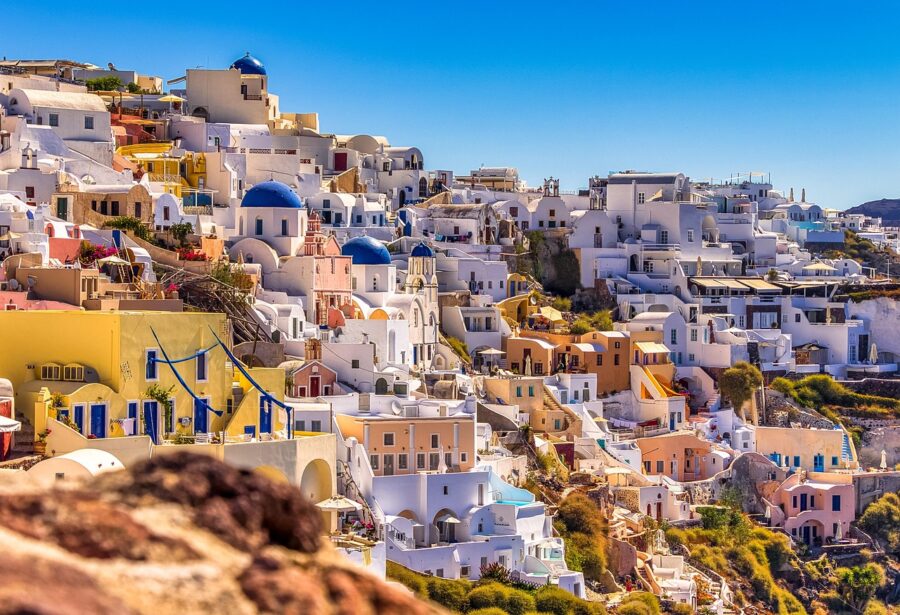
Some mistakes happen before you even set foot on Santorini. Timing, packing, and a bit of prep can turn a trip from stressful to smooth. It’s not rocket science, but a little attention here saves you a lot of hassle.
Not Booking in Advance
Santorini draws crowds—huge ones—especially from late spring through early fall. Hotels in Oia and Fira can sell out months ahead, and ferry tickets for the best times vanish fast.
If you wait, you might get stuck with overpriced rooms far from the main sights. The same goes for the popular tours—sunset cruises, wine tastings, volcano hikes—they fill up weeks out.
You don’t need to plan every second, but lock in your essentials early. Book your flights or ferries, your hotel, and any must-do activities before you land. I use Expedia to compare options and lock in better rates.
Ignoring Weather Patterns
Santorini’s weather can surprise you. Summer brings heat, crowds, and barely a cloud in the sky. Spring and autumn? Milder, quieter, and honestly, my favorite times to visit.
In July and August, the sun is relentless—think over 30°C and almost no shade. Winter can be rough, with ferry cancellations thanks to strong winds, and many hotels close up shop.
Check the forecast, especially if you’re taking a ferry from Athens. The Aegean’s meltemi winds can throw a wrench in your plans. If you’ve got wiggle room, late May or early October is a sweet spot—good weather, fewer people, and better deals.
Overpacking for the Island
Let me tell you, lugging a heavy suitcase up Santorini’s endless steps is a workout nobody asks for. I’ve been there, sweating and regretting every extra pair of shoes I packed.
Most places to stay are clinging to the cliffside, and elevators are a myth here. So, seriously—pack light.
Grab airy clothes, comfy shoes, and toss in something nice for evenings out. Unless you’re braving winter, leave the bulky coats at home.
If you show up early and your room isn’t ready yet, stash your stuff at luggage storage near the port or in town. Hauling bags around those hills? Hard pass.
I’d recommend picking up some travel gear that’s versatile enough for other trips, not just Santorini.
Frequently Asked Questions
Santorini’s gorgeous, but it isn’t just blue domes and perfect sunsets everywhere you look. Some spots get a little dicey, and a few customs might trip you up if you’re not paying attention.
A bit of local know-how saves you from classic rookie tourist mistakes.
Which areas in Santorini should tourists be cautious about visiting for safety reasons?
You’re safe almost everywhere, but the cliff paths linking Fira, Firostefani, and Oia get super slippery after rain. I’ve seen more than a few flip-flop casualties—trust me, stick with sturdy shoes.
At night, Fira’s narrow streets fill up with scooters and ATVs weaving through the crowds. Stay alert when you’re walking around.
Are there any particular local customs in Santorini that visitors should be careful not to offend?
Greeks appreciate politeness. Even a simple “Kalimera” (good morning) when you walk into a shop or café makes a difference.
Skip the pointing at people, and don’t touch religious icons unless you know it’s okay. Churches here are sacred spaces, not just photo ops—cover up a bit if you go inside.
What are some common mistakes tourists make when dressing for a vacation in Santorini?
People forget how windy it gets. Wear a loose skirt or a floppy hat without a strap, and you’ll be chasing it down the street.
And those cobblestone alleys? High heels are a nightmare. Go for sneakers or flat sandals—you’ll be happier after your first climb.
Can you identify certain tourist activities in Santorini that are considered overrated or not worthwhile?
Honestly, those pricey “sunset dinner” deals in Oia? Not worth it. You can catch the same sunset for free from plenty of public spots.
Boat tours to the volcano sound epic, but it’s just a rocky hill with some steam. If you’re expecting fireworks, you might be disappointed.
What behaviors should be avoided on Santorini beaches to respect Greek beach etiquette?
Keep your music down unless you’re at a dedicated party beach. Most people come for the chill vibe and the sound of the waves.
And don’t leave trash behind—especially cigarette butts. Greek beaches are stunning, but only if everyone does their part.
What actions are deemed disrespectful when interacting with the residents of Santorini?
If you whip out your camera and start snapping photos of people without asking, you’re bound to ruffle some feathers. Locals—especially the older folks—aren’t extras in your vacation album.
Another thing? Pushing for discounts in those tiny family-run shops just doesn’t fly here. Sure, you might bargain at a flea market somewhere else, but in Santorini, it usually just comes off as a bit rude.

